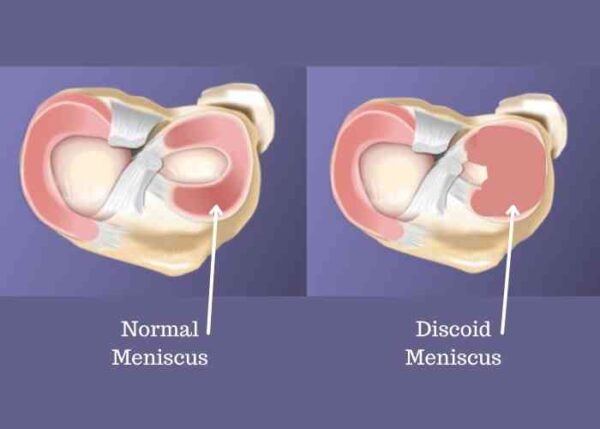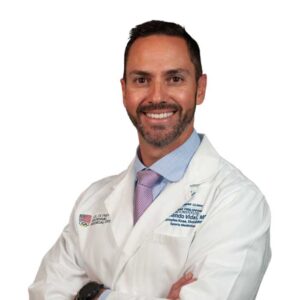What is Discoid Meniscus?
The knee has two wedge-shaped pieces of cartilage called menisci that sit between the bones of the knee and acts as a cushion to protect the bones during movement. If this cartilage is oval, or disc-shaped instead of c-shaped and it is thicker than normal, it is called a discoid meniscus. Individuals with discoid meniscus may never experience any problems. However, some will have knee problems related to the discoid meniscus, often beginning in childhood. Dr. Armando Vidal, pediatric orthopedic specialists treats patients with discoid meniscus in Vail, Aspen and the surrounding Denver, Colorado communities.

What causes discoid meniscus?
Discoid meniscus is a congenital disorder of the knee joint. Most patients born with this type of cartilage do not experience symptoms and participate in sports and other activities like any other child or teen. Although it is counterintuitive that having more meniscus could be a bad thing, because of its abnormal shape a discoid meniscus is more prone to injury than a normally shaped meniscus. The thick, abnormal shape of a discoid meniscus makes it more likely to tear or cause a catching sensation in the knee.
What types of discoid meniscus are there?
Discoid meniscus is separated into three types:
- Incomplete – The meniscus is slightly thicker and wider than normal, usually asymptomatic.
- Complete – The meniscus covers the tibial plateau completely.
- Hypermobile Wrisberg – The meniscus is not attached to the femur or the tibia due to missing ligaments. This can cause the meniscus to slip into the joint causing locking, popping and pain.
What are the symptoms of discoid meniscus?
Patients usually have problems with discoid meniscus within the first two decades of life. Symptoms include:
- Pain and/or tenderness in the knee, usually on the lateral side (outside of the leg.)
- Sharp or stabbing pain when running, jumping or deep squatting.
- Swelling in the knee.
- Loss of motion.
- Catching or locking – the knee “gets stuck” when fully bending or straightening.
- Quadriceps weakness (thigh muscles).
- Pain when walking up or down stairs or an incline.
Who is more prone to problems with a discoid meniscus?
There is a higher prevalence in the Asian population of discoid meniscus. Studies also show patients who have the Wrisberg type of discoid meniscus are 20% more likely to have it in both knees. Children who have symptoms before the age of 12 are 5-times more likely to eventually require meniscus surgery of some type on both knees. Females with a BMI (body mass index) over 32, or in the obese range, are more likely to experience symptoms from a discoid meniscus and are more likely to have articular cartilage damage.
What can be done for pediatric patients with discoid meniscus?
Patients in Vail, Aspen and the surrounding Denver, Colorado communities who do not have symptoms are usually treated by Dr. Vidal with watchful observation. Dr. Vidal prefers a conservative approach to symptomatic patients, especially when the discoid meniscus is not damaged.
Patients who have experienced a tear or who are having painful symptoms may need surgical intervention. Dr. Vidal will carefully consider the patient’s age, skeletal age and differing treatment options. Ideally, a repair of the meniscus can be done to preserve meniscal function. Some surgical options include:
- Saucerizing – Trimming the damaged cartilage tissue and reconstituting a normal outline of the lateral meniscus.
- Repair of the meniscus
- Resection (removal) of the meniscus
- Partial Menisectomy – Removing only the damaged part of the meniscus that cannot heal by itself.
What is the recovery after a discoid meniscus repair?
Patients need to commit to a well-guided physical therapy protocol which is essential to a good outcome following a discoid meniscus repair. Adolescents will need to avoid jumping, twisting and high-impact activities until they have healed completely. Dr. Vidal advises against deep squatting activities and against sitting cross-legged following discoid meniscus repair.
Most patients return to normal daily and sports activities within a few months.
Discoid Meniscus Surgeon
Does discoid meniscus run in your family? If so, your child may be at risk of developing complications due to a discoid meniscus. These complications typically show up at some point during childhood and vary in severity. If your child is in pain or experiencing a loss of range of motion or strength, come see Doctor Armando Vidal. Dr. Vidal is a pediatric cartilage surgeon and has served young patients in Vail, Aspen, and the surrounding Denver, Colorado communities who are experiencing discoid meniscus for years. Contact Dr. Vidal’s team today!

Locations
180 S Frontage Rd W
Vail, CO 81657
226 Lusher Court
Ste 101
Frisco, CO 80443
322 Beard Creek Road
Edwards, CO 81632


